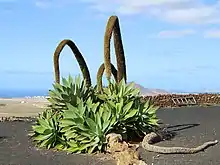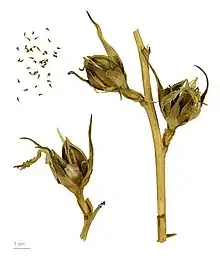Agave attenuata
Agave attenuata is a species of agave commonly known as the Foxtail, Lion's tail or Swan's Neck Agave for its development of a curved inflorescence, unusual among agaves.[3] Native to the plateaus of central west Mexico, as one of the unarmed agaves, it is popular as an ornamental plant in gardens in many other places with subtropical and warm climates.[4]
| Agave attenuata | |
|---|---|
 | |
| Scientific classification | |
| Kingdom: | Plantae |
| Clade: | Tracheophytes |
| Clade: | Angiosperms |
| Clade: | Monocots |
| Order: | Asparagales |
| Family: | Asparagaceae |
| Subfamily: | Agavoideae |
| Genus: | Agave |
| Species: | A. attenuata |
| Binomial name | |
| Agave attenuata Salm-Dyck 1834 | |
| Synonyms[2] | |
| |
Description

Although the plant can appear acaulescent, stems often reach 50 to 150 cm (20–60 in) in length, and old leaves fall off, leaving the stems visible. The leaves are ovate-acuminate, 50–70 cm (20–28 in) long and 12–16 cm (5–6 in) wide, pale in color, ranging from a light gray to a light yellowish green. There are no teeth, nor terminal spines, although the leaves taper to soft points that fray with age. The numerous, egg-shaped and tapered leaves are slightly softer than most Agave species, they are bright glaucous-gray to light yellowish green and stingless.[5]
The inflorescence is a dense raceme 2.5 to 3 meters (8 to 10 ft) high (usually curved), with greenish-yellow flowers, growing after many years.[6] As with other Agave species, the plant dies after floration occurs, but numerous suckers consequently sprout both from the base of the plant and from the flower raceme.
It has two subspecies:
Range
Specimens were sent to Kew by the explorer Galeotti in 1834, from an unspecified location in central Mexico. A more recent study has reported it from Jalisco east to Mexico, in small colonies at elevations of 1,900 to 2,500 meters (6,200 to 8,200 ft), but there have been few sightings, suggesting this agave is rare in the wild.[6] In Mexico, it is distributed in the states of Colima, Durango, Guerrero, Jalisco, Michoacán, Nayarit, and México State in altitudes between 400 and 2,500 meters (1,300 and 8,200 ft) on volcanic rock clifs within pine forests and transitional zones of tropical dry and temperate forest types in mountains.[1] It is reportedly naturalized in Libya[9][10] and Madeira[10] and is widely spread through the Mediterranean and the rest of Macaronesia.
Cultivation

In cultivation, Agave attenuata is said to prefer relatively moist loamy soil, although it can cope with poor soil and dry conditions. It should be protected from direct sunlight in summer and from long periods of frost.[11] It is hardy down to USDA Zone 9b.[12][13]
Gallery
 A specimen leaning as the stem grows
A specimen leaning as the stem grows Flower raceme of an Agave attenuata
Flower raceme of an Agave attenuata.jpg.webp) Flower closeup
Flower closeup Seeds after floration occurs
Seeds after floration occurs Seeds sprouting from the flower raceme
Seeds sprouting from the flower raceme
References
- García-Mendoza, A.J., Sandoval-Gutiérrez, D., Torres-García, I. & Linares, J. (2019). "Agave attenuata". IUCN Red List of Threatened Species. 2019: e.T114936958A114963376. Retrieved 18 January 2021.CS1 maint: multiple names: authors list (link)
- The Plant List, Agave attenuata
- Robert Zander : Zander hand dictionary of plant names. Edited by Fritz Encke , Günther Buchheim, Siegmund Seybold .15th edition, corrected reprint of the 14th edition. Eugen Ulmer, Stuttgart 1994, ISBN 3-8001-5072-7
- http://www.cactus-art.biz/schede/AGAVE/Agave_attenuata/Agave_attenuata/Agave_attenuata.htm
- Joachim Thiede: Agave chamelensis . In: Urs Eggli (ed.): Succulent lexicon. Monocotyledons (monocotyledons) . Eugen Ulmer, Stuttgart 2001, ISBN 3-8001-3662-7 , P. 14-15 .
- Howard Scott Gentry, Agaves of Continental North America (University of Arizona Press, 1982) pp. 66-71
- "Agave attenuata subsp. attenuata". Catalogue of Life. Retrieved 18 January 2021.
- "Agave attenuata subsp. dentata (J.Verschaff.) B.Ullrich". Catalogue of Life. Retrieved 18 January 2021.
- Gordon Cheers (ed.): Botanica . Random House Australia 2003. German edition: Tandem Verlag GmbH 2003, ISBN 3-8331-1600-5
- "Agave attenuata Salm-Dyck". Catalogue of Life. Retrieved 18 January 2021.
- Agave attenuata, The Lovely Plants
- "Agave Species, Durango Soft Agave, Century Plant, Maguey". davesgarden.com. Retrieved 18 January 2021.
- "Agave attenuata (Fox Tail Agave)". worldofsucculents.com. Retrieved 18 January 2021.
External links
| Wikimedia Commons has media related to Agave attenuata. |
